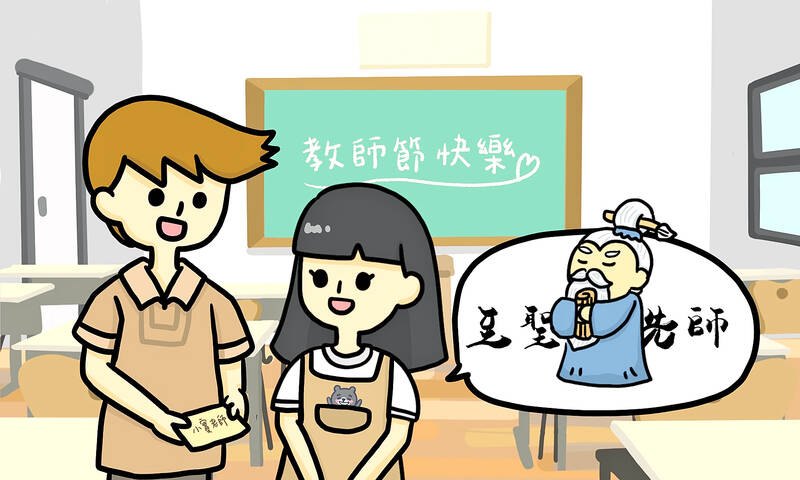對話 Dialogue
馬克:小實,這張卡片給你,祝你「教師節快樂」!

Mǎkè: Xiǎoshí, zhè zhāng kǎpiàn gěi nǐ, zhù nǐ “jiàoshī jié kuàilè!”
小實:咦?是給我的嗎?可是我不是你的老師啊!
Xiǎoshí: Yí? Shì gěi wǒ de ma? Kěshì wǒ búshì nǐ de lǎoshī a!
馬克:你教了我很多中文,所以你是我的中文老師。
Mǎkè: Nǐ jiāole wǒ hěnduō Zhōngwén, suǒyǐ nǐ shì wǒ de Zhōngwén lǎoshī.
小實:謝謝你這麼貼心!你怎麼知道教師節快到了?
Xiǎoshí: Xièxie nǐ zhème tiēxīn! Nǐ zěnme zhīdào jiàoshī jié kuài dào le?
馬克:是我的朋友告訴我的,他說九月二十八號是孔子的生日。
Mǎkè: Shì wǒ de péngyǒu gàosù wǒ de, tā shuō jiǔ yuè èrshíbā hào shì Kǒngzǐ de shēngrì.
小實:嗯,這是一種常見的說法。對了!美國也有教師節嗎?
Xiǎoshí: En, zhè shì yìzhǒng chángjiàn de shuōfǎ. Duìle! Měiguó yěyǒu jiàoshī jié ma?
馬克:有啊!美國的教師節在五月。
Mǎkè: Yǒu a! Měiguó de jiàoshī jié zài wǔ yuè.
小實:好,那我到時候也要好好感謝你常常教我英文。
Xiǎoshí: Hǎo, nà wǒ dào shíhòu yě yào hǎohǎo gǎnxiè nǐ chángcháng jiāo wǒ Yīngwén.
翻譯 Translation
Mark: Xiaoshi, this card is for you. “Happy Teachers’ Day!”
Xiaoshi: Huh...? Is it for me? But I am not your teacher!
Mark: You taught me a lot of Chinese, so you are my Chinese teacher.
Xiaoshi: Thank you for being so considerate! How do you know Teachers’ Day is coming?
Mark: My friend told me that Sept. 28 is Confucius’ birthday.
Xiaoshi: Well, this is a common saying. Oh, by the way, is there a Teachers’ Day in the US?
Mark: Yes! Teachers’ Day in the US falls in May.
Xiaoshi: OK, then I will also thank you for teaching me English.
單字片語 Vocabulary
1. 教師節 (jiàoshī jié) Teachers’ Day
2. 咦 (yí) huh
3. 貼心 (tiēxīn) to be thoughtful, considerate
4. 孔子 (Kǒngzǐ) Confucius
5. 常見 (chángjiàn) common
6. 說法 (shuōfǎ) statement, way of saying a story
7. 到時候 (dào shíhòu) by the time, then
8. 感謝 (gǎnxiè) grateful
教材音檔 Audio Files
教材影片 Video Files:
https://www.instagram.com/celc.nou_tw/guide/_/17999106352646292/
實踐大學華語中心提供
By Shih Chien University Chinese Language Center: https://chineseusc.com/

In most cities, food waste is often regarded as one of the most troublesome types of waste: it has a high moisture content, spoils easily and produces strong odors. If not handled properly, it can cause serious sanitation and environmental problems. From the perspective of the circular economy, however, food waste is not “useless leftovers,” but rather an organic resource that has yet to be effectively utilized. The core principle of the circular economy is to break away from the linear model of “production–consumption–disposal,” allowing resources to circulate repeatedly within a system and extending their useful life. Food waste occupies a

A: Google has unveiled its 2025 Year in Search chart. No. 10 to No. 6 are: Typhoon Podul, Chinese drama “Love’s Ambition,” tariffs, US President Donald Trump and singer Khalil Fong’s death. B: Wow, actress Rosy Zhao’s new drama is so popular. So what are the top five? A: No. 5 to No. 1 are: Gemini, hanzii.net, NT$10,000 cash handout, entertainer Big S’ death and earthquakes. B: Hasn’t Trump topped this year’s most-searched people chart? A: Yup, and he’s closely followed by cheerleader GuoGuo Chiang at No. 2, whose husband Zack Fanchiang is also at No. 8. Apparently, people are curious about her extramarital

In June, headlines shocked the art world when a visitor damaged a 17th-century painting at the Uffizi Galleries in Florence, Italy, while posing for a photograph. This was not an isolated event. Recently, similar disasters have been reported worldwide, from a child damaging a Mark Rothko painting to a tourist breaking an exhibit by pretending to sit on it. Such incidents highlight why museum etiquette is increasingly crucial. First, we must recognize that art and historical objects are fragile. Once damaged, they may never regain their original condition. Many common actions, though harmless at first glance, can have grave consequences. For

對話 Dialogue 清清:後天就是聖誕節了! Qīngqing: Hòutiān jiùshì Shèngdàn jié le! 華華:但也是我們的行憲紀念日,從今年開始又恢復放假了。 Huáhua: Dàn yě shì wǒmen de Xíngxiàn Jìniànrì, cóng jīnnián kāishǐ yòu huīfù fàngjià le. 清清:只有一天吧?沒有彈性放假,對嗎? Qīngqing: Zhǐ yǒu yì tiān ba? Méiyǒu tánxìng fàngjià, duì ma? 華華:對,就是星期四休一天。 Huáhua: Duì, jiùshì xīngqísì xiū yì tiān. 清清:你那天有什麼安排? Qīngqing: Nǐ nèitiān yǒu shénme ānpái? 華華:我想吃聖誕大餐,然後跟家人交換禮物。 Huáhua: Wǒ xiǎng chī Shèngdàn dàcān, ránhòu gēn jiārén jiāohuàn lǐwù. 清清:聽說樓下的部門也辦交換禮物派對,我們要不要也辦一個? Qīngqing: Tīngshuō lóuxià de bùmén yě bàn jiāohuàn lǐwù pàiduì, wǒmen yào búyào yě bàn yí ge? 華華:喔!好啊!那你問問大家的意見吧! Huáhua: Ō! Hǎo a! Nà nǐ wènwen dàjiā de yìjiàn ba! 翻譯 Translation Qingqing: The day after tomorrow is Christmas. Huahua: It’s also Constitution Day in Taiwan. Starting this year, we get the day off again. Qingqing: